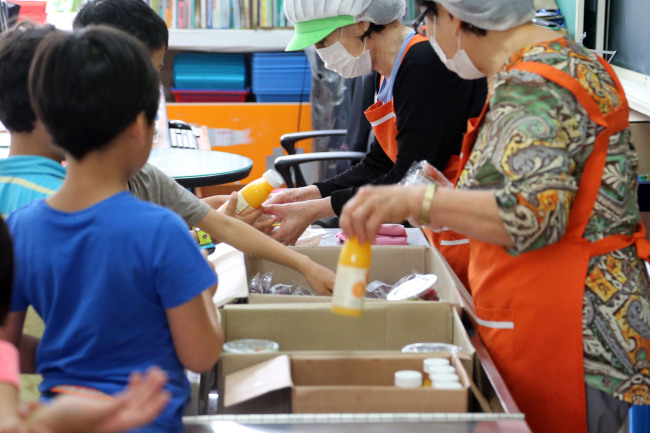School meal complaints grow
Students opt to buy their own lunches, cooking staffs urge change in labor conditions
By Korea HeraldPublished : July 3, 2016 - 16:54
A photo of a school lunch at Bongsan Elementary School in Daejeon recently went viral and prompted a heated debate on social media.
A chicken skewer, a cube of watermelon, a slice of pickle and a handful of noodles were placed on a food tray. It was prepared as a lunch for elementary school students aged approximately 7 to 12.
Not only did the meal seem to lack enough nutritional value for a growing child, but it also seemed unable to justify the fixed price per meal at 3,000-3,500 won ($2.60-$3).
“Why do innocent schoolchildren have to eat this poor meal?” read one comment. “It is really shocking and sad for them,” said another.
Hygiene at the school’s kitchen was also found to be inadequate. Some fifth and sixth graders said they sometimes found hair, tissues and plastic pieces in their meals. One government investigation, found that food trays contained up to 5,979 types of bacteria, about 30 times more than would normally be expected.
A chicken skewer, a cube of watermelon, a slice of pickle and a handful of noodles were placed on a food tray. It was prepared as a lunch for elementary school students aged approximately 7 to 12.
Not only did the meal seem to lack enough nutritional value for a growing child, but it also seemed unable to justify the fixed price per meal at 3,000-3,500 won ($2.60-$3).
“Why do innocent schoolchildren have to eat this poor meal?” read one comment. “It is really shocking and sad for them,” said another.
Hygiene at the school’s kitchen was also found to be inadequate. Some fifth and sixth graders said they sometimes found hair, tissues and plastic pieces in their meals. One government investigation, found that food trays contained up to 5,979 types of bacteria, about 30 times more than would normally be expected.

The Daejeon Metropolitan Office of Education immediately released an apology and vowed to conduct a special audit into Bongsan Elementary School through a committee comprising parents, civic groups and field experts. As a result, seven faculty staff in the school kitchen, including a nutritionist and cook, lost their jobs.
South Korea’s public schools have been providing meals since 2003. A total of 6.14 million students at some 11,700 elementary, middle, high and special schools nationwide were provided meals from Monday to Friday at their schools as of February, according to the Education Ministry.
The current School Meals Act states that the local government is responsible for ensuring meals are nutritional and produced in hygienic conditions. After a huge food poisoning scandal broke out in schools in Incheon in 2006, stricter regulations, such as mandatory food service from school-operated kitchens and penalty systems, were introduced.
Despite the government and municipalities’ efforts to improve conditions at school kitchens and meals, complaints have continued to grow among students and workers at school kitchens.
Jeong Su-bin, a 17-year-old high school student in Suwon, told The Korea Herald that she buys her lunch from a nearby convenience store on her way to school. She said the diverse options to choose for her meal, despite most of them presumably containing significant amounts of preservatives, was the biggest merit of not relying on the school kitchen.
“Food at my school is simply not tasty,” said Jeong, adding she normally buys bulgogi kimbap or crab sandwiches.
Jeong said she started to buy her own meals after she was told to eat all the leftovers on her food tray. She said she was given a large portion from the staff at the school kitchen, and was forced to eat it all due to the penalty system at her school.
“It was like a nightmare. Why do I have to eat bad-tasting food just because it was on my food tray?” asked Jeong.

Many of the schools here face problems from food waste, which costs a tremendous amount of money to dispose of each year.
According to Seoul Metropolitan Office of Education, at least 2 billion won was spent in 2015 to dispose of 15,970 tons of food waste at schools in Seoul. This accounted for 13.3 percent of the total school support budget provided by the government.
Statistics in 2013 showed that an average of 30.8 kilograms of food waste was produced by a single high school student each year, while an average of 15.1 kilograms of food waste was produced by an elementary school student.
In order to prevent accumulation of food waste, some schools prepare meals with a minimum amount of ingredients or cook with ingredients that can be stored for a long period of time, leading to poor quality.
According to a recent investigation by authorities, 16 schools in North Gyeongsang Province were caught using ingredients that had expired.
In order to calm public distrust toward school meals and criticisms from parents, the Education Ministry said Thursday that it would implement active monitoring and conduct evaluations on food service at schools by checking a photo uploaded by the school kitchen every day of the meal distributed on the food tray.
The ministry explained that it was to offer a transparent food service system that was open and accessible to all students, parents and authorities.
Those who do not upload a photo will be given a penalty point during the food service evaluation that is conducted twice a year by the local government.
However, industry workers point to what they see as a more fundamental cause -- the need for better working conditions for cooking staff. They added that cooking staff, mostly temporary workers, are faced with discriminatory treatment at the workplace compared to nutritionists.
“There is a big gap in treatment between nutritionists and cooking staff at school kitchens. A lot of the cooks are very often neglected and treated unfairly,” said Kim Jin-sook, head of the nutritionist association, citing a lack of communication between them as another big issue.
“A reduced workload and an improved labor environment for the cooking staff would naturally lead to better quality of school meals,” said an official from the labor union for temporary workers at schools.
According to the current Enforcement Decree of the School Meal Act, the related regulation only addresses the duty and role of a nutrition teacher, someone who, as a licensed teacher, should be able to “guide and supervise the kitchen staff.”
By Kim Da-sol (ddd@heraldcorp.com)
-
Articles by Korea Herald




![[Herald Interview] 'Amid aging population, Korea to invite more young professionals from overseas'](http://res.heraldm.com/phpwas/restmb_idxmake.php?idx=644&simg=/content/image/2024/04/24/20240424050844_0.jpg&u=20240424200058)












![[KH Explains] Korean shipbuilding stocks rally: Real growth or bubble?](http://res.heraldm.com/phpwas/restmb_idxmake.php?idx=652&simg=/content/image/2024/04/25/20240425050656_0.jpg&u=)

